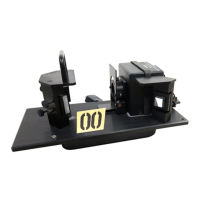AQ-00073-000, Rev. 7 16
Assuming that the spatial distribution of energy reflected from this unknown sample is the same
as that of the original standard, the efficiency factor (
κ
) will be the same for both materials:
Therefore, the value displayed by the instrument will simply be equal to the ratio of the reflec-
tance factor of the unknown sample to that of the original standard:
If the reflectance factor of this original standard is known, it can be used as a reference standard
and the reflectance factor of the unknown sample can be derived as follows:
This operation is known as the reference correction to distinguish it from background correction
described in this manual.
The foregoing account involves two simplifying assumptions that bear further discussion. First,
the efficiencies of the integrating sphere, represented by
κ
r
,κ
s
and
κ
u,
are not necessarily con-
stant under changes in the system, as suggested by Equations 3a and 4a. The introduction of a
reflectance or transmittance sample into the system may change the sphere efficiency. It is com-
monly assumed, however, that the sphere efficiencies
will change by the same factor. This factor
is eliminated when the instrument records its ratio, so that the foregoing analysis remains valid.
The second assumption applies to reflectance factor measurements and is represented by Equa-
tion 5. Here it is assumed that the geometric scattering properties of the sample and the reference
D
R
S
R
B
------=
E
s
ρ
u
κ
u
E
r
ρ
r
κ
r
E
r
ρ
r
κ
r
E
s
ρ
s
κ
s
----------------------------------
ρ
u
κ
u
ρ
s
κ
s
-----------==
Eq. 4b
κ
u
κ
s
=
Eq. 5
D
R
ρ
u
ρ
s
-----=
Eq. 6a
ρ
u
D
R
ρ
s
=
Eq. 6b

